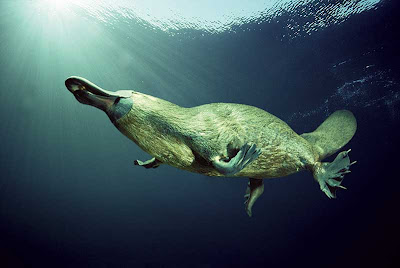The Life of Animals | Platypus | The body and the broad, flat tail of the platypus are covered with dense, brown fur That traps a layer of insulating the water to keep the animal warm. The platypus uses its tail for storage of fat reserves (an adaptation also found in animals Such as the Tasmanian devil and fat-tailed sheep). The webbing is more significant on the front feet and is folded back walking on land. Unlike a bird's beak (in the which the upper and lower parts separate to reveal the mouth), the snout of the platypus is a sensory organ with the mouth on the Underside. The nostrils are located on the dorsal surface of the snout, while the eyes and ears are located in a groove set just back from it this groove is closed swimming.
Weight varies considerably from 0.7 to 2.4 kg (1.5 to 5.3 lb), with males being larger than females: males average 50 cm (20 in) in total length while females average 43 cm (17 in). The platypus has an average body temperature of about 32 ° C (90 ° F) rather than the 37 ° C (99 ° F) typical of placental Mammals.
Modern platypus young have three-cusped molars, the which They lose before or just after leaving the breeding Burrow; adults have heavily keratinised pads in Their place. The platypus jaw is constructed differently from That of other Mammals, and the jaw-opening muscle is different. When the platypus was first encountered by European naturalists, They were the resource persons Divided over whether the female laid eggs.
Mindful of the high cost of wiring England per word, Caldwell famously but tersely wired London, "Monotremes Oviparous, meroblastic ovum." That is, monotremes lay eggs, and the eggs are similar to Those of Reptiles in That only part of the egg divides as it develops. The species Exhibits a single breeding season; Occurs the between June and October, with some local variation taking place the between different Populations across its range. Historical observation, mark-and-recapture studies, and preliminary Investigations of population genetics indicate the possibility of Both resident and transient members of Populations, and suggest a polygynous system.
The male takes no part in caring for its young, and retreats to its year-long Burrow. The female softens the ground in the Burrow with dead, folded, wet leaves and She fills the nest at the end of the tunnel with fallen leaves and reeds for bedding material. The female platypus has a pair of ovaries, but only the left one is functional.
After laying her eggs, the female curls around Them. The Incubation period is Divided into three phases. The yolk is absorbed by the developing young. During the second phase, the digits develop and, in the last phase, the egg tooth Appears. The newly hatched young are vulnerable, blind, and hairless, and are fed by the mother's milk. Although possessing mammary glands, the platypus lacks teats. During Incubation and weaning, the mother leaves the Burrow initially only for short periods, to forage. When doing so, She creates a number of thin soil plugs along the length of the Burrow, possibly to protect the young from predators; pushing past these on her return forces water from her fur and allows the Burrow to Remain dry.






No comments:
Post a Comment